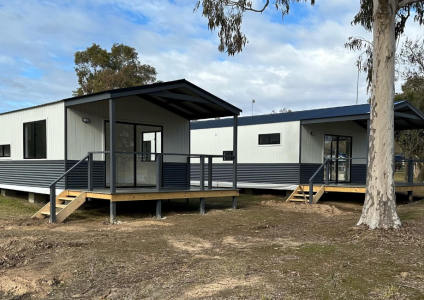Affordable home ownership made possible with this revolutionary financial lending change
By
Gian T
- Replies 0
Amid Australia’s growing housing challenges, a new development offers hope to those struggling with affordability.
A major financial institution has introduced a policy that could reshape how Australians think about home ownership. An alternative housing option, once considered niche, is now gaining recognition as a practical and accessible solution.
With faster construction times and reduced costs, this approach could be a game-changer for those seeking affordable living.
Take Angela, a Sydney-based research institute employee, eyeing a prefab home as her retirement sanctuary.
'I live in Sydney, so buying anywhere here is completely out of the question,' she said.
'I’m nearing 60, so I’m looking at it as an actual viable retirement plan for me. I currently work in Sydney, so I rent in Sydney, but that’s not viable for my future.'
Instead, she's considering purchasing land in rural New South Wales, where she can place a prefab home that won't break the bank.
Eryn Norris, a university student from the Central Coast, has embraced the prefab lifestyle by setting up a compact 42 square metre home in her mother's backyard.
For $98,000, she's secured a private space complete with all the essentials while still enjoying the proximity to her family.
'Mum loves it. She enjoys that I’m close, but I can still have my space, and she has an extra bedroom back in her house,' she expressed.
Commonwealth Bank of Australia's pioneering move to offer loans for prefab home builds is a significant departure from traditional financing models.
Historically, homeowners have had to shoulder up to 90 per cent of construction costs, with banks only stepping in for the final 10 per cent once the home is in place.
CBA's new policy flips the script, offering loans for up to 60 per cent of the total contract price—and an impressive 80 per cent for those using bank-accredited manufacturers—before the home is even affixed to the land.
Michael Baumann, CBA's executive general manager of home buying, acknowledged the challenges that have historically plagued prefab financing.
'We want to alleviate some of the financial barriers associated with prefabricated properties,' he explained.
'We believe these upcoming changes will help to achieve just that, giving more Australians the chance to look at this way of building a home, which could, in turn, help deliver more supply to market faster.'
This could lead to a surge in supply, bringing more homes to the market at a faster pace.
The potential impact of this shift is staggering. PennyGranny, a prefab building company, estimates that over half a million Australian households in major cities could legally add a granny flat to their property.
This could translate into thousands of new, quickly-built homes, alleviating the rental crisis and expanding affordable housing options.
The prefab industry is on the brink of a boom, with PrefabAUS reporting that 680 companies generated $11.4 million in revenue in 2023, accounting for 7 per cent of the construction industry's value.
This figure is expected to balloon to 30 per cent over the next decade, signalling a seismic shift in the building landscape.
Whether you're planning for retirement, seeking a downsizing option, or simply exploring alternative housing solutions, prefabricated homes offer a promising avenue.
With CBA's lending change, the dream of affordable home ownership is closer to reality than ever before.
In other news, rental prices in Sydney and Melbourne have remained stagnant, showing no growth over the past six months.
Across the country, rental prices have risen at their slowest pace since late 2021, increasing by 6.9 per cent annually. You can read more about it here.

Have you considered a prefab home? What are your concerns or experiences with this type of dwelling? Share your stories and join the conversation below. Let's navigate the future of housing together, one prefab at a time.
A major financial institution has introduced a policy that could reshape how Australians think about home ownership. An alternative housing option, once considered niche, is now gaining recognition as a practical and accessible solution.
With faster construction times and reduced costs, this approach could be a game-changer for those seeking affordable living.
Take Angela, a Sydney-based research institute employee, eyeing a prefab home as her retirement sanctuary.
'I live in Sydney, so buying anywhere here is completely out of the question,' she said.
'I’m nearing 60, so I’m looking at it as an actual viable retirement plan for me. I currently work in Sydney, so I rent in Sydney, but that’s not viable for my future.'
Instead, she's considering purchasing land in rural New South Wales, where she can place a prefab home that won't break the bank.
Eryn Norris, a university student from the Central Coast, has embraced the prefab lifestyle by setting up a compact 42 square metre home in her mother's backyard.
For $98,000, she's secured a private space complete with all the essentials while still enjoying the proximity to her family.
'Mum loves it. She enjoys that I’m close, but I can still have my space, and she has an extra bedroom back in her house,' she expressed.
Commonwealth Bank of Australia's pioneering move to offer loans for prefab home builds is a significant departure from traditional financing models.
Historically, homeowners have had to shoulder up to 90 per cent of construction costs, with banks only stepping in for the final 10 per cent once the home is in place.
CBA's new policy flips the script, offering loans for up to 60 per cent of the total contract price—and an impressive 80 per cent for those using bank-accredited manufacturers—before the home is even affixed to the land.
Michael Baumann, CBA's executive general manager of home buying, acknowledged the challenges that have historically plagued prefab financing.
'We want to alleviate some of the financial barriers associated with prefabricated properties,' he explained.
'We believe these upcoming changes will help to achieve just that, giving more Australians the chance to look at this way of building a home, which could, in turn, help deliver more supply to market faster.'
The potential impact of this shift is staggering. PennyGranny, a prefab building company, estimates that over half a million Australian households in major cities could legally add a granny flat to their property.
This could translate into thousands of new, quickly-built homes, alleviating the rental crisis and expanding affordable housing options.
The prefab industry is on the brink of a boom, with PrefabAUS reporting that 680 companies generated $11.4 million in revenue in 2023, accounting for 7 per cent of the construction industry's value.
This figure is expected to balloon to 30 per cent over the next decade, signalling a seismic shift in the building landscape.
Whether you're planning for retirement, seeking a downsizing option, or simply exploring alternative housing solutions, prefabricated homes offer a promising avenue.
With CBA's lending change, the dream of affordable home ownership is closer to reality than ever before.
In other news, rental prices in Sydney and Melbourne have remained stagnant, showing no growth over the past six months.
Across the country, rental prices have risen at their slowest pace since late 2021, increasing by 6.9 per cent annually. You can read more about it here.
Key Takeaways
- Prefabricated homes are gaining attention as an affordable solution to Australia's housing crisis, and the Commonwealth Bank (CBA) is now offering loans for their purchase and construction.
- These homes are built off-site and can be constructed in a matter of weeks, making them a cheaper and quicker option than traditional houses.
- Under CBA's new policy, customers can borrow up to 60 per cent of the total contract price, or up to 80 per cent if using a bank-accredited manufacturer, before the prefab home is affixed to the land.
- The financing changes could significantly increase the number of prefab homes built, providing immediate relief for the rental crisis and offering more affordable housing options to Australians.
Last edited:








